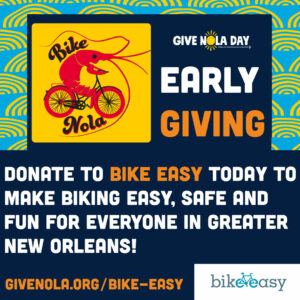A nola.com op-ed from Rob Henig Bell, Campaign Manager at Bike Easy
Updated 7:44 AM; Today 7:30 AM
Author: By Robert Henig Bell, guest columnist
By Robert Henig Bell, guest columnist
It’s springtime in New Orleans, a perfect time to bike around and soak in all the sights, sounds and smells in the air. This spring, it’s also a season of change for biking and mobility.
Progress is taking shape to increase safety and access to people in more neighborhoods, but if we’re going to secure an accessible, equitable and sustainable future for transportation in New Orleans we need to be thoughtful, transparent and inclusive.
This is the first in a series of essays from the New Orleans Complete Streets Coalition, local organizations pushing to rebuild our streets so they’re built for everyone who uses them — people walking, biking, driving, and riding transit. Much of the discussion recently has been about bikes and bike safety, but this issue is actually bigger than that. Ultimately, this is a conversation about our freedom to choose how we get around.
That’s why advocates like us at Bike Easy are so excited about the City of New Orleans committing to building up to 75 miles of protected bike lanes over the next two years. We’re also committed, and we hope the city is too, to ensuring all our streets are planned and built for all types of travel, and for healthy, equitable and livable communities for decades to come. That requires a new, robust, fully implemented Complete Streets policy for New Orleans.
Over the past year, a lot has happened for biking in New Orleans. We collaborated with the city to demonstrate the potential of connected and protected bikeway networks. That project, Connect The Crescent, temporarily reorganized downtown streets to expand ridership, improve safety and collect community feedback. It worked!
Of the more than 800 residents surveyed, 87 percent said they felt safer with physical barriers installed to separate people driving and people biking. On every street where a protected lane was installed, the number of people biking increased between 20 percent to 84 percent.
At the same time, median speeds of cars and trucks remained the same, while dangerous and illegal speeding decreased significantly. This is a window looking out at a brighter future: streets designed to encourage people to bike and to walk, thereby reducing congestion and hazards like speeding and drunk driving.
We have the experience. We have the data that shows how big a difference a protected bike commute can make. With a big push to protect new and existing routes, biking to work or school is about to become a safe option for thousands who don’t feel comfortable doing so today, especially kids, seniors and people with disabilities.
New bikeways to be installed will appear alongside new crosswalks to improve overall safety at many dangerous intersections. At the same time, RTA is being reformed to expand public transportation. Taken together, these efforts are creating new, safe and affordable transportation options for everyone who lives and works in New Orleans.
These are great steps forward toward maximizing our city’s potential to become the most walkable and bikeable city in the country. From Bike Easy’s perspective, and as you’ll read in forthcoming essays from our coalition partners, the way to make sure we actually get there is for our city government to adopt a data-driven and equity-focused Complete Streets program.
Safe biking routes, accessible walking paths and reliable public transportation need to reach every neighborhood, particularly those most in need. The people of New Orleans deserve a publicly accountable process, and this administration needs to build on the progress they’ve already made by building a culture that views safe biking, prioritized transit lines, traffic-calming measures and green infrastructure as priorities, not afterthoughts.
We’ve been recently reminded, with the horrific crash on Esplanade Avenue during Mardi Gras, why so many of our friends and neighbors choose not to ride at all. They don’t feel safe. It’s time we realize what a huge missed opportunity this state of affairs is for New Orleans.
With just a slight shift in priorities we can safely and efficiently share our roads, by making sure people biking, people walking, and people driving each know where they’re supposed to be on the road. Like that high ground between the river and the lake where this city was founded 300 years ago, New Orleans is well-positioned to become America’s premier city for biking and walking. We’re already the best city for dancing in the streets, so why not?
Robert Henig Bell is the campaign manager at Bike Easy, a non-profit advocacy organization working to improve biking and walking in and around New Orleans.

